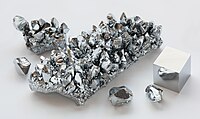
Photo from wikipedia
Greece contains several gem corundum deposits set within diverse geological settings, mostly within the Rhodope (Xanthi and Drama areas) and Attico-Cycladic (Naxos and Ikaria islands) tectono-metamorphic units. In the Xanthi… Click to show full abstract
Greece contains several gem corundum deposits set within diverse geological settings, mostly within the Rhodope (Xanthi and Drama areas) and Attico-Cycladic (Naxos and Ikaria islands) tectono-metamorphic units. In the Xanthi area, the sapphire (pink, blue to purple) deposits are stratiform, occurring within marble layers alternating with amphibolites. Deep red rubies in the Paranesti-Drama area are restricted to boudinaged lenses of Al-rich metapyroxenites alternating with amphibolites and gneisses. Both occurrences are oriented parallel to the ultra-high pressure/high pressure (UHP/HP) Nestos suture zone. On central Naxos Island, colored sapphires are associated with desilicated granite pegmatites intruding ultramafic lithologies (plumasites), occurring either within the pegmatites themselves or associated metasomatic reaction zones. In contrast, on southern Naxos and Ikaria Islands, blue sapphires occur in extensional fissures within Mesozoic metabauxites hosted in marbles. Mineral inclusions in corundums are in equilibrium and/or postdate corundum crystallization and comprise: spinel and pargasite (Paranesti), spinel, zircon (Xanthi), margarite, zircon, apatite, diaspore, phlogopite and chlorite (Naxos) and chloritoid, ilmenite, hematite, ulvospinel, rutile and zircon (Ikaria). The main chromophore elements within the Greek corundums show a wide range in concentration: the Fe contents vary from (average values) 1099 ppm in the blue sapphires of Xanthi, 424 ppm in the pink sapphires of Xanthi, 2654 ppm for Paranesti rubies, 4326 ppm for the Ikaria sapphires, 3706 for southern Naxos blue sapphires, 4777 for purple and 3301 for pink sapphire from Naxos plumasite, and finally 4677 to 1532 for blue to colorless sapphires from Naxos plumasites, respectively. The Ti concentrations (average values) are very low in rubies from Paranesti (41 ppm), with values of 2871 ppm and 509 in the blue and pink sapphires of Xanthi, respectively, of 1263 ppm for the Ikaria blue sapphires, and 520 ppm, 181 ppm in Naxos purple, pink sapphires, respectively. The blue to colorless sapphires from Naxos plumasites contain 1944 to 264 ppm Ti, respectively. The very high Ti contents of the Xanthi blue sapphires may reflect submicroscopic rutile inclusions. The Cr (average values) ranges from 4 to 691 ppm in the blue, purple and pink colored corundums from Naxos plumasite, is quite fixed (222 ppm) for Ikaria sapphires, ranges from 90 to 297 ppm in the blue and pink sapphires from Xanthi, reaches 9142 ppm in the corundums of Paranesti, with highest values of 15,347 ppm in deep red colored varieties. Each occurrence has both unique mineral assemblage and trace element chemistry (with variable Fe/Mg, Ga/Mg, Ga/Cr and Fe/Ti ratios). Additionally, oxygen isotope compositions confirm their geological typology, i.e., with, respectively δ18O of 4.9 ± 0.2‰ for sapphire in plumasite, 20.5‰ for sapphire in marble and 1‰ for ruby in mafics. The fluid inclusions study evidenced water free CO2 dominant fluids with traces of CH4 or N2, and low CO2 densities (0.46 and 0.67 g/cm3), which were probably trapped after the metamorphic peak. The Paranesti, Xanthi and central Naxos corundum deposits can be classified as metamorphic sensu stricto (s.s.) and metasomatic, respectively, those from southern Naxos and Ikaria display atypical magmatic signature indicating a hydrothermal origin. Greek corundums are characterized by wide color variation, homogeneity of the color hues, and transparency, and can be considered as potential gemstones.
Journal Title: Minerals
Year Published: 2019
Link to full text (if available)
Share on Social Media: Sign Up to like & get
recommendations!